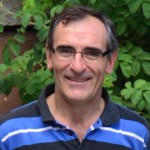Events on March 27, 2020

Dr. Pablo Laguna, Aragón Institute for Engineering Research (I3A)., Zaragoza University, Spain Presents:
Signal Processing Guided by Physiology: Making the Most of Bioelectrical Signals
March 27, 2020 at 2:00pm for 1hr
Evans Conference Room, WEB 3780
Warnock Engineering Building, 3rd floor.
Abstract:
Biomedical signals convey information about biological systems, and can emanate from varied origins, e.g., electrical, mechanical, or chemical. In particular, biomedical signals can provide relevant information on the function of the human body. This information, however, may not be apparent in the signal due to measurement noise, presence of signals coming from other interacting subsystems, or simply because it is not visible to the human eye. Signal processing is usually required to extract the relevant information from biomedical signals and convert it into meaningful data that physicians can interpret. In this respect, knowledge of the physiology behind the biomedical measurements under analysis is fundamental. Not considering the underlying physiology may lead, in the best case, to processing methods that do not fully exploit the biomedical signals being analyzed and thus extract only partially their meaningful information. In the worst case the result may be processing methods that distort or even remove the information of interest in those signals.
Biomedical signal processing (BSP) tools are typically applied on just one particular signal recorded at a unique level of the functional system under investigation and with limited knowledge of the interrelationships with other components of that system. In most instances though, BSP can benefit from an analysis in which more than one signal is evaluated at a time (multi-modal processing), different levels of function are considered (multi-scale processing), and scientific input from different disciplines is incorporated (multi-disciplinary processing). For each problem at hand, the BSP researcher should decide to what extent information from a number of signals, functional levels, or disciplines need to be incorporated to solve the problem.
As an example, a multi-scale model may be necessary in cases where, for instance, a deeper knowledge of the cell and tissue mechanisms required to interpret the signals from the heart or brain. In other case, a simplified single-scale model may be sufficient. At present, there are many biomedical signals that can be acquired and processed using relatively low-cost systems, which makes their use in the clinics very extensive. In particular, non-invasive signals readily accessible to physicians are increasingly being used to improve the diagnosis, treatment and monitoring of a variety of diseases.
This presentation aims to illustrate the role played by BSP in the analysis of cardiovascular signals. A set of applications will be presented where BSP contributes to improve our knowledge, with that main emphasis on atrial arrhythmias. We will also briefly described applications in ventricular arrhythmias, the modulation of cardiac activity by the autonomic nervous system (ANS), and the interactions between cardiac and respiratory signals.
Bio:
Dr. Laguna is a professor of Signal Processing and Communications and the Director of the Biomedical Signal Interpretation & Computational Simulation Center. Pablo has been vice-dean for international relations (1999-2002), and a researcher at the Aragón Institute for Engineering Research (I3A), both at University of Zaragoza, Spain, where he directed the Biomedical Engineering division of the I3A (2000-2011) and of the masters program in Biomedical Engineering (2003-2010). He is also member, and has served as scientific director (2011-2015), of the Spanish Center for Biomedical Engineering, Biomaterial, and Nano-medicine Research CIBER-BBN.
Dr. Laguna's professional research interests are in Signal Processing, in particular applied to Biomedical applications. He has co-authored more than 150 research papers on this topic, over 300 international conference papers, and has advised 15 Ph.D students. He leads a broad range of projects on biomedical signal interpretation, especially in the cardiovascular domain, most of them with international collaborations at clinical and engineering sites. He has served as President and Past President of the board of directors of Computing in Cardiology Society, editor of the digital signal processing journal (Eurasip), and of the Medical and Biological Engineering and Computing (springer). He is also Director of the Ph.D. program in Biomedical Engineering at Zaragoza University. He is Fellow of the IEEE and IAMBE and, together with L. Sörnmo, the author of Bioelectrical Signal Processing in Cardiac and Neurological Applications, book (Elsevier, 2005).
Posted by: Nathan Galli




